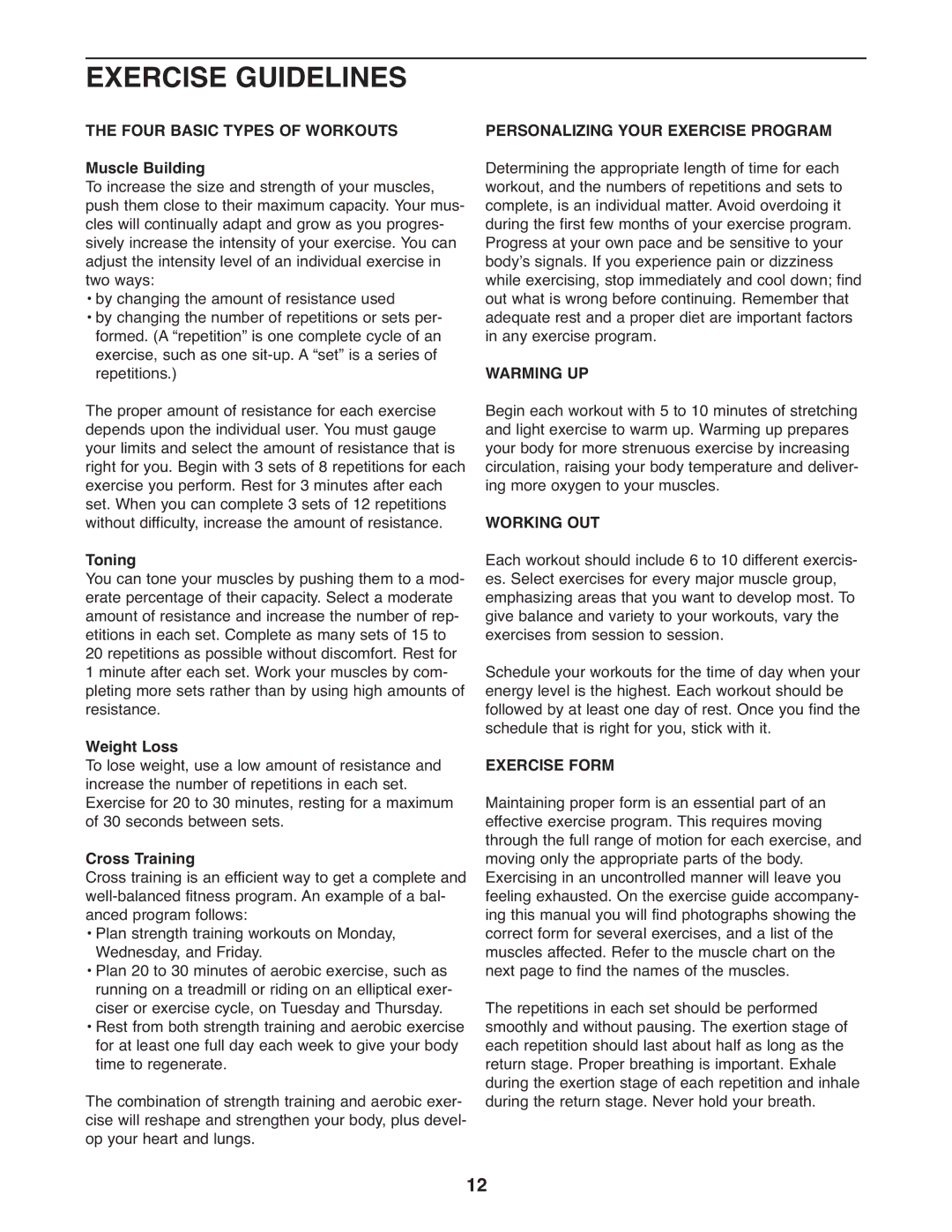EXERCISE GUIDELINES
THE FOUR BASIC TYPES OF WORKOUTS | PERSONALIZING YOUR EXERCISE PROGRAM |
Muscle Building | Determining the appropriate length of time for each |
To increase the size and strength of your muscles, | workout, and the numbers of repetitions and sets to |
push them close to their maximum capacity. Your mus- | complete, is an individual matter. Avoid overdoing it |
cles will continually adapt and grow as you progres- | during the first few months of your exercise program. |
sively increase the intensity of your exercise. You can | Progress at your own pace and be sensitive to your |
adjust the intensity level of an individual exercise in | body’s signals. If you experience pain or dizziness |
two ways: | while exercising, stop immediately and cool down; find |
• by changing the amount of resistance used | out what is wrong before continuing. Remember that |
• by changing the number of repetitions or sets per- | adequate rest and a proper diet are important factors |
formed. (A “repetition” is one complete cycle of an | in any exercise program. |
exercise, such as one | WARMING UP |
repetitions.) | |
The proper amount of resistance for each exercise | Begin each workout with 5 to 10 minutes of stretching |
depends upon the individual user. You must gauge | and light exercise to warm up. Warming up prepares |
your limits and select the amount of resistance that is | your body for more strenuous exercise by increasing |
right for you. Begin with 3 sets of 8 repetitions for each | circulation, raising your body temperature and deliver- |
exercise you perform. Rest for 3 minutes after each | ing more oxygen to your muscles. |
set. When you can complete 3 sets of 12 repetitions | WORKING OUT |
without difficulty, increase the amount of resistance. | |
Toning | Each workout should include 6 to 10 different exercis- |
You can tone your muscles by pushing them to a mod- | es. Select exercises for every major muscle group, |
erate percentage of their capacity. Select a moderate | emphasizing areas that you want to develop most. To |
amount of resistance and increase the number of rep- | give balance and variety to your workouts, vary the |
etitions in each set. Complete as many sets of 15 to | exercises from session to session. |
20 repetitions as possible without discomfort. Rest for | Schedule your workouts for the time of day when your |
1 minute after each set. Work your muscles by com- | |
pleting more sets rather than by using high amounts of | energy level is the highest. Each workout should be |
resistance. | followed by at least one day of rest. Once you find the |
Weight Loss | schedule that is right for you, stick with it. |
To lose weight, use a low amount of resistance and | EXERCISE FORM |
increase the number of repetitions in each set. | Maintaining proper form is an essential part of an |
Exercise for 20 to 30 minutes, resting for a maximum | |
of 30 seconds between sets. | effective exercise program. This requires moving |
Cross Training | through the full range of motion for each exercise, and |
moving only the appropriate parts of the body. | |
Cross training is an efficient way to get a complete and | Exercising in an uncontrolled manner will leave you |
feeling exhausted. On the exercise guide accompany- | |
anced program follows: | ing this manual you will find photographs showing the |
• Plan strength training workouts on Monday, | correct form for several exercises, and a list of the |
Wednesday, and Friday. | muscles affected. Refer to the muscle chart on the |
• Plan 20 to 30 minutes of aerobic exercise, such as | next page to find the names of the muscles. |
running on a treadmill or riding on an elliptical exer- | The repetitions in each set should be performed |
ciser or exercise cycle, on Tuesday and Thursday. | |
• Rest from both strength training and aerobic exercise | smoothly and without pausing. The exertion stage of |
for at least one full day each week to give your body | each repetition should last about half as long as the |
time to regenerate. | return stage. Proper breathing is important. Exhale |
The combination of strength training and aerobic exer- | during the exertion stage of each repetition and inhale |
during the return stage. Never hold your breath. | |
cise will reshape and strengthen your body, plus devel- |
|
op your heart and lungs. |
|
12
